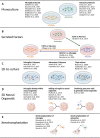Human iPSC-derived glia models for the study of neuroinflammation
- PMID: 37817184
- PMCID: PMC10566197
- DOI: 10.1186/s12974-023-02919-2
Human iPSC-derived glia models for the study of neuroinflammation
Abstract
Neuroinflammation is a complex biological process that plays a significant role in various brain disorders. Microglia and astrocytes are the key cell types involved in inflammatory responses in the central nervous system. Neuroinflammation results in increased levels of secreted inflammatory factors, such as cytokines, chemokines, and reactive oxygen species. To model neuroinflammation in vitro, various human induced pluripotent stem cell (iPSC)-based models have been utilized, including monocultures, transfer of conditioned media between cell types, co-culturing multiple cell types, neural organoids, and xenotransplantation of cells into the mouse brain. To induce neuroinflammatory responses in vitro, several stimuli have been established that can induce responses in either microglia, astrocytes, or both. Here, we describe and critically evaluate the different types of iPSC models that can be used to study neuroinflammation and highlight how neuroinflammation has been induced and measured in these cultures.
Keywords: Astrocytes; Co-culture; Cytokines; Induced pluripotent stem cells; Microglia; Monoculture; Neural organoids; Neuroinflammation; Xenotransplantation; iPSC.
© 2023. BioMed Central Ltd., part of Springer Nature.
Conflict of interest statement
The authors declare no competing interests.
Figures

References
Publication types
MeSH terms
Grants and funding
LinkOut - more resources
Full Text Sources

